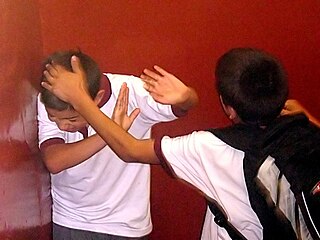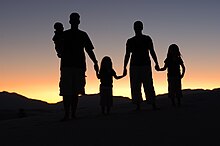
Conduct disorder (CD) is a mental disorder diagnosed in childhood or adolescence that presents itself through a repetitive and persistent pattern of behavior that includes theft, lies, physical violence that may lead to destruction, and reckless breaking of rules, in which the basic rights of others or major age-appropriate norms are violated. These behaviors are often referred to as "antisocial behaviors", and is often seen as the precursor to antisocial personality disorder; however, the latter, by definition, cannot be diagnosed until the individual is 18 years old. Conduct disorder may result from parental rejection and neglect and can be treated with family therapy, as well as behavioral modifications and pharmacotherapy. Conduct disorder is estimated to affect 51.1 million people globally as of 2013.
Antisocial personality disorder is a personality disorder characterized by a limited capacity for empathy and a long-term pattern of disregard or violation of the rights of others. Other notable symptoms include impulsivity and reckless behavior, a lack of remorse after hurting others, deceitfulness, irresponsibility, and aggressive behavior.

In psychology, codependency is a theory that attempts to explain imbalanced relationships where one person enables another person's self-destructive behavior such as addiction, poor mental health, immaturity, irresponsibility, or under-achievement.

Alcohol abuse encompasses a spectrum of unhealthy drinking behaviors which range from consuming more than 2 drinks per day on average for men, or more than 1 drink per day on average for women, to binge drinking or alcohol use disorder.

Sexual behaviors in children are common and may range from normal and developmentally appropriate to abusive. These behaviors may include self-stimulation, interest in sex, curiosity towards sex and the opposite gender, exhibitionism, voyeurism, gender role behaviors and engagement in interpersonal sexual acts.

Physical abuse is any intentional act causing injury or trauma to another person or animal by way of bodily contact. In most cases, children are the victims of physical abuse, but adults can also be victims, as in cases of domestic violence or workplace aggression. Alternative terms sometimes used include physical assault or physical violence, and may also include sexual abuse. Physical abuse may involve more than one abuser, and more than one victim.
A spoiled child or spoiled brat is a derogatory term aimed at children who exhibit behavioral problems from being overindulged by their parents or other caregivers. Children and teens who are perceived as spoiled may be described as "overindulged", "grandiose", "narcissistic" or "egocentric-regressed". When the child has a neurological condition such as autism, ADHD or intellectual disability, observers may see them as "spoiled”. There is no specific scientific definition of what "spoiled" means, and professionals are often unwilling to use the label because it is considered vague and derogatory. Being spoiled is not recognized as a mental disorder in any of the medical manuals, such as the ICD-10 or the DSM-IV, or its successor, the DSM-5.
Oppositional defiant disorder (ODD) is listed in the DSM-5 under Disruptive, impulse-control, and conduct disorders and defined as "a pattern of angry/irritable mood, argumentative/defiant behavior, or vindictiveness". This behavior is usually targeted toward peers, parents, teachers, and other authority figures, including law enforcement officials. Unlike conduct disorder (CD), those with ODD do not generally show patterns of aggression towards random people, violence against animals, destruction of property, theft, or deceit. One half of children with ODD also fulfill the diagnostic criteria for ADHD.

Child abuse is physical, sexual, emotional and/or psychological maltreatment or neglect of a child, especially by a parent or a caregiver. Child abuse may include any act or failure to act by a parent or a caregiver that results in actual or potential wrongful harm to a child and can occur in a child's home, or in organizations, schools, or communities the child interacts with.
Emotional dysregulation is a range of emotional responses that do not lie within a desirable scope of emotive response, considering the stimuli.
Sibling abuse includes the physical, psychological, or sexual abuse of one sibling by another. More often than not, the younger sibling is abused by the older sibling. Sibling abuse is the most common of family violence in the US, but the least reported. As opposed to sibling rivalry, sibling abuse is characterized by the one-sided treatment of one sibling to another.
Childhood trauma is often described as serious adverse childhood experiences (ACEs). Children may go through a range of experiences that classify as psychological trauma; these might include neglect, abandonment, sexual abuse, emotional abuse, and physical abuse, witnessing abuse of a sibling or parent, or having a mentally ill parent. These events have profound psychological, physiological, and sociological impacts and can have negative, lasting effects on health and well-being such as unsocial behaviors, attention deficit hyperactivity disorder (ADHD), and sleep disturbances. Similarly, children whose mothers have experienced traumatic or stressful events during pregnancy have an increased risk of mental health disorders and other neurodevelopmental disorders.
Child-on-child sexual abuse is a form of child sexual abuse in which a prepubescent child is sexually abused by one or more other children or adolescents, and in which no adult is directly involved. While this includes when one of the children uses physical force, threats, trickery or emotional manipulation to elicit cooperation, it also can include non-coercive situations where the initiator proposes or starts a sexual act that the victim does not understand the nature of and simply goes along with, not comprehending its implications or what the consequences might be.
Charles L. Whitfield was an American medical doctor in private practice specializing in assisting survivors of childhood trauma with their recovery, and with addictions including alcoholism and related disorders. He was certified by the American Society of Addiction Medicine, a founding member of the National Association for the Children of Alcoholics, and a member of the American Professional Society on the Abuse of Children.

Substance abuse prevention, also known as drug abuse prevention, is a process that attempts to prevent the onset of substance use or limit the development of problems associated with using psychoactive substances. Prevention efforts may focus on the individual or their surroundings. A concept that is known as "environmental prevention" focuses on changing community conditions or policies so that the availability of substances is reduced as well as the demand. Individual Substance Abuse Prevention, also known as drug abuse prevention involves numerous different sessions depending on the individual to help cease or reduce the use of substances. The time period to help a specific individual can vary based upon many aspects of an individual. The type of Prevention efforts should be based upon the individual's necessities which can also vary. Substance use prevention efforts typically focus on minors and young adults – especially between 12–35 years of age. Substances typically targeted by preventive efforts include alcohol, tobacco, marijuana, inhalants, coke, methamphetamine, steroids, club drugs, and opioids. Community advocacy against substance use is imperative due to the significant increase in opioid overdoses in the United States alone. It has been estimated that about one hundred and thirty individuals continue to lose their lives daily due to opioid overdoses alone.

Alcoholism in family systems refers to the conditions in families that enable alcoholism and the effects of alcoholic behavior by one or more family members on the rest of the family. Mental health professionals are increasingly considering alcoholism and addiction as diseases that flourish in and are enabled by family systems.
Victimization refers to a person being made into a victim by someone else and can take on psychological as well as physical forms, both of which are damaging to victims. Forms of victimization include bullying or peer victimization, physical abuse, sexual abuse, verbal abuse, robbery, and assault. Some of these forms of victimization are commonly associated with certain populations, but they can happen to others as well. For example, bullying or peer victimization is most commonly studied in children and adolescents but also takes place between adults. Although anyone may be victimized, particular groups may be more susceptible to certain types of victimization and as a result to the symptoms and consequences that follow. Individuals respond to victimization in a wide variety of ways, so noticeable symptoms of victimization will vary from person to person. These symptoms may take on several different forms, be associated with specific forms of victimization, and be moderated by individual characteristics of the victim and/or experiences after victimization.
Adult Children of Alcoholics founded circa 1973 is a fellowship of people who desire to recover from the effects of growing up in an alcoholic or otherwise dysfunctional family. ACA membership has few formal requirements. ACA does not accept any outside contributions and is supported entirely by donations from its members. The organization is not related to any particular religion and has no political affiliation. Tony A. was among its co-founders and is the author of The Laundry List, 12 steps for adult children of alcoholics, The Problem, which are all published in his book, The Laundry List: The ACOA Experience
The effects of domestic violence on children have a tremendous impact on the well-being and developmental growth of children witnessing it. Children who witness domestic violence in the home often believe that they are to blame, live in a constant state of fear, and are 15 times more likely to be victims of child abuse. Close observation during an interaction can alert providers to the need for further investigation and intervention, such as dysfunctions in the physical, behavioral, emotional, and social areas of life, and can aid in early intervention and assistance for child victims.
Adverse childhood experiences (ACEs) include childhood emotional, physical, or sexual abuse and household dysfunction during childhood. The categories are verbal abuse, physical abuse, contact sexual abuse, a battered mother, household substance abuse, household mental illness, incarcerated household members, and parental separation or divorce. The experiences chosen were based upon prior research that has shown to them to have significant negative health or social implications, and for which substantial efforts are being made in the public and private sector to reduce their frequency of occurrence. Scientific evidence is mounting that such adverse childhood experiences (ACEs) have a profound long-term effect on health. Research shows that exposure to abuse and to serious forms of family dysfunction in the childhood family environment are likely to activate the stress response, thus potentially disrupting the developing nervous, immune, and metabolic systems of children. ACEs are associated with lifelong physical and mental health problems that emerge in adolescence and persist into adulthood, including cardiovascular disease, chronic obstructive pulmonary disease, autoimmune diseases, substance abuse, and depression.
References Cont.







